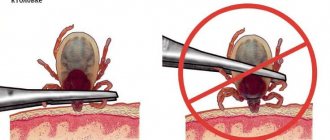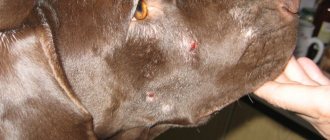What will you learn from the article?
- The causative agent of demodicosis in cats is the subcutaneous mite. Routes of infection
- Risk group
- Diagnostics
- Treatment of localized form
Demodectic mange in cats is a parasitic disease that affects the skin and hair of animals. The cause of this disease is the subcutaneous demodex mite. In our article we will tell you which ectoparasites cause pathology, what are the first symptoms of infection, what forms of the disease exist, and how it is treated.
What is the danger of subcutaneous mite infection?
Infection with subcutaneous mites (red scabies or (by the name of the pathogen) demodicosis) threatens even those pets that never go outside.
The tick bite itself does not pose a danger to the pet, but it brings a lot of unpleasant sensations to it.
If treatment is not treated promptly, your pet may develop problems:
- aesthetic: skin lesions;
- loss of a significant part of the coat;
The severity of the skin disease depends on the type of microorganism infecting the animal and the breed of cat (some have a higher risk of infection).
Tick-borne encephalitis in a cat
With tick-borne encephalitis, the virus that enters the bloodstream during a tick bite travels through the bloodstream to the brain. Inflammation of the gray matter of the brain occurs, swelling of the cerebral cortex develops and the cat dies from complications, including paralysis, loss of vision and epilepsy.
Carriers of encephalitis
The carrier of encephalitis is most often Ixodes Persulcatus (taiga tick), which inhabits the Asian and some European regions of Russia, as well as Ixodes Ricinus (European forest tick), which has chosen its European territories.
In addition, representatives of the family Haemaphysalis are also capable of transmitting encephalitis . These ticks live in the deciduous forests of Transcaucasia, Crimea and the Far East. The threat of infection with encephalitis, tularemia and Omsk hemorrhagic fever also comes from ticks of the genus Dermacentor.
Clinical picture of the disease
The acute form of the disease is observed in cats with reduced immunity several hours after the bite. Over the course of a day, the disease worsens: the cat becomes febrile and unsteady, it does not respond to food and water, diarrhea and profuse salivation begin, the mucous membranes turn pale, and muscle pain appears. It all ends with convulsions, paralysis and falling into a coma.
In cats with stronger immunity, the disease drags on for 2 weeks, manifesting itself in the incubation phase with weakness, a slight (2-3°) increase in temperature, discharge from the nose and eyes, and refusal to eat. After 9-14 days, a malfunction occurs in the central nervous system: convulsions and paralysis are noted, the animal loses consciousness or falls into a lethargic state.
Treatment. In the acute course of the disease, replacement therapy, corticosteroids and intravenous injections are indicated. Along with this, the cat receives immunostimulants, vitamins, antihistamines, antipyretics, painkillers and absorbents.
If encephalitis has transformed into chronic meningitis, complications cannot be avoided, and treatment of the pet will take more than one month.
Subcutaneous mites: types and what affects them
There are several types of subcutaneous mites:
- Demodex (provokes demodicosis);
- Sarcoptes scabiei (sarcoptosis);
- Notoedrosis (notoedrosis);
- Cheyletiella (cheyletiellosis);
- Trombiculidae (thrombiculosis).
Infection with each of them causes specific symptoms in the animal.
Demodicosis
Most often, Demodectic mange (scabies) in cats is caused by the parasite Demodex, which is not even a mite; it is more correct to use the name glandular acne.
Demodex mites cannot be seen without a microscope
This microorganism normally lives in the hair follicles of humans and animals and feeds on sebum, which, in general, has a positive effect on skin health. But with certain metabolic disorders, Demodex has a destructive effect on the skin. Moreover, the negative impact of the parasite on the body is due to the result of its vital activity - it begins to secrete harmful toxins and dies after 15–25 days, which provokes the process of decomposition in the thickness of the skin. The result is redness, irritation, itching and suppuration.
The subcutaneous demodex mite in a cat is called opportunistic - malfunctions in the body lead to skin disease
Demodicosis, or scabies, in humans, dogs and cats is caused by different types of microorganisms. In cats, these are Demodex gatoi and Demodex cati. In humans and dogs - Demodex folliculorum. However, cats that suffer from chronic pathologies or have suffered severe stress, as well as young individuals, are susceptible to infection with the “human” tick.
Video: demodicosis in animals
Sarcoptic mange
The causative agent of sarcoptic mange is Sarcoptes scabiei.
The symptoms are similar to demodicosis, but compared to it it is more aggressive: ulcers appear, in the worst case - deep lesions of the epidermis, fistulas.
The chronic form has unpleasant consequences: the skin becomes keratinized in the affected areas, covered with pigment spots and scar-like tubercles.
With sarcoptic mange, microscopic mites devour the epidermis, causing discomfort and pain to the animal.
Notoedrosis
Notoedrosis is caused by a parasite of the genus Notoedrosis. This is the largest among subcutaneous mites. Affects the entire body of the animal. This tick is transmitted from cats to humans and pets through contact.
After infecting the host, it lives for about a month and dies. It does not reproduce in human skin (unlike animal skin). Eggs that fall on household items can become a source of spread of the disease.
Notoedrosis is a parasitic disease of cats, characterized by a high degree of contagiousness, including to humans.
Accompanied by already familiar symptoms:
- itching;
- irritation;
- hair loss.
Cheyletiellosis
The parasite Cheyletiella leads to the development of cheyletiellosis. Among the symptoms:
- the appearance of dandruff and itching;
- peeling of the skin.
It is transmitted from a sick animal to a healthy one. The lesion has clear boundaries; the skin of the back usually suffers.
Thrombiculosis
Thrombiculosis is caused by mites of the genus Trombiculidae.
This parasite is very tenacious. It lives both in the ground and on the body and skin of mammals, insects and birds. Attached in groups. There is a symbiosis of young and adult individuals. Primarily affects the mucous membranes:
- lips;
- anus;
- nose;
- eyes.
The parasite is easy to notice with the naked eye. To do this, look for soft, bright red dots measuring 0.5 mm on your cat's body. When you crush a group of such points, you will get a characteristic scarlet stain.
Video: diseases caused by subcutaneous mites in cats
How does infection occur?
The tick is transmitted through saliva, fur, and microtraumas when a sick animal comes into contact with a healthy one.
Infection will occur only if the animal’s immune system is weakened, its metabolism is impaired, i.e. it is at risk, and this is:
- pregnant cats;
- old individuals;
- animals with chronic diseases;
- kittens.
Kittens can become infected from their mother. The tick can also be transmitted through common hygiene products that the cat comes into contact with.
If the cat has a strong immune system, it can become a carrier of the pathogen: it will not get sick, but it can transmit it to other animals.
Prevention
Subcutaneous mites cause a number of diseases that require long-term, serious treatment, which causes cats a lot of inconvenience and takes a lot of their energy. It does not lead to the formation of immune defense in the animal and therefore no one can guarantee that the animal will not get sick again. Therefore, the owner needs to take care of disease prevention:
- keep the cat's fur and ears clean,
- organize a balanced diet,
- See your veterinarian more often
- limit his contact with stray animals,
- use anti-flea collars, ointments and sprays.
Symptoms of the disease
Infestation with subcutaneous mites can be identified by the following manifestations:
- oozing nodules or bumps on the skin;
- redness on the body, changes in skin pigmentation;
- skin thickening;
- focal hair loss;
- “demodicosis glasses” - the cat loses hair around the eyes;
- peeling and itching of the skin;
- bleeding wounds;
- deterioration of health.
Photo gallery: signs of activation of the subcutaneous mite
Red bumps on the skin - a concentration of subcutaneous mites
Due to inflammation and strong friction during scabies, areas of the skin turn red
Hair loss is one of the main symptoms of subcutaneous mite infestation.
Hair loss around the eyes is a marker of demodicosis
Severe itching is the first sign of a tick-borne infection
With mild local forms of damage, self-healing is possible.
In particularly severe forms of the disease, intoxication of the entire cat’s body occurs with waste products of the tick. In this case, complications are possible in the form of:
- further decrease in immunity;
- decreased skin barrier function;
- formation of purulent foci;
- enlarged lymph nodes.
Possible complications
In the absence of proper treatment, subcutaneous mites in a cat can cause a number of negative consequences:
- development of pathogenic microflora inside the body,
- improper formation of hair follicles,
- chronic necrosis processes on the skin of an animal,
- general intoxication of the cat’s body.
The animal becomes thin, emaciated, and takes on an unkempt, patchy appearance. He is plagued by frequent respiratory and gastrointestinal diseases.
Treatment
It is worth understanding that there are several forms of the disease, and treatment depends on which one affects your cat. Therefore, in order to build the right rehabilitation program for your pet, you need to contact a veterinarian. This is especially true for advanced cases.
Veterinary methods
The treatment offered by the veterinarian comes down to the following steps:
- Cleansing animal skin. To do this, use Doctor or Elite shampoos.
- Getting rid of scabs and crusts on the affected areas. Hydrogen peroxide or chlorhexidine solution is used. After treatment, be sure to dry the animal's skin.
- Treating your pet's skin with anti-mite preparations. In consultation with your doctor, it is possible to treat problem areas with Citeal solution, which should be used at least 2-3 times a day. Emulsions are also used (according to the instructions):
- Advocate;
- Stronghold;
- Butox 50;
- Amitraz.
- After the crusts and scabs have come off, choose one remedy from the list:
- Ivermek-gel;
- Aversectin ointment;
- Demos liniment;
- Amidel-gel;
- sulfur ointment.
- Restoration of skin in affected areas. Produced after anti-mite treatment. For this purpose use:
- olive and linseed oils;
- Tsipam;
- Amit;
- Mycodemocid;
- Ectodes.
- Additional processing. After the oil or solution has dried, additional anti-parasite ointments are applied. It can be:
- Amitrazine;
- Cythiotate;
- Saphroderm.
- Restoring immunity. It is recommended to give your cat vitamins prescribed by your doctor, maintain a healthy diet and use:
- Immunol;
- Maxidin;
- Immunoparasite;
- Gala Vet;
- Gamavit.
- In severe cases - when a secondary infection occurs - antibiotics are prescribed:
- Ligfol;
- Amoxicillin;
- Baytril;
- Betamox;
- Kanamycin.
Photo gallery: drugs for the treatment of subcutaneous mites
Amidel-gel is used to treat dogs and cats older than 2 months with skin lesions from mites
Amitrazine is a veterinary drug that is used for cats in the treatment of pathologies caused by sarcoptic mites
Stronghold is a systemic antiparasitic drug used against a number of insects, sarcoptic mites and nematodes.
The veterinary drug Tsipam is used to treat cats, fur-bearing animals, dogs with otodectosis, notoedrosis, psoroptosis, demodicosis, sarcoptic mange.
Gamavit is a multivitamin complex that is used in traditional veterinary medicine to normalize the immune system.
ethnoscience
If the disease has just begun to manifest itself or is mild, you can try to help your pet at home:
- Clean the victim's skin with soap or gel containing birch tar.
- To soothe affected areas, use calendula tincture.
- Bath your cat in chamomile decoction or apply it locally (can be repeated every 2-3 days).
Remember: cats' skin is more sensitive than human skin. Traditional medicine often offers treatment with aggressive agents (sulfur, tar, kerosene), which dry out the pet's skin and do not heal, but rather cripple the pet.
If you observe lethargy, decreased appetite, pale mucous membranes, increased temperature, or formation of suppuration in a furry patient, consult a doctor immediately.
Treatment of kittens and pregnant cats
Kittens and pregnant cats are among the groups at increased risk of becoming infected with subcutaneous mites. There are certain difficulties in their treatment.
When treating a cat, it is important that the drug does not get into the milk or amniotic membranes, i.e., that it is not absorbed. Therefore, topical preparations should be used. These include, for example, Frontline. Before applying it, you should clean the animal’s skin, remove scabs, and then lubricate it with oil.
In complicated forms of the disease, such treatment is not enough. This means a trip to the vet cannot be avoided.
When treating kittens, the recommendations are similar. It is worth considering that there are a number of drugs that are contraindicated for young cats. It will be impossible to find a medicine without a professional.
Let's say you decide to use Ivermectin. It is prescribed for serious lesions, but the medicine cannot be used for kittens under 3 months of age.
In both cases, you should not do treatment at home. It is better to contact a veterinarian at the first symptoms of your pet being infected with a subcutaneous tick.
Remember: the sooner you contact your veterinarian, the better the treatment outcome will be. Removing subcutaneous mites from a cat is a difficult and time-consuming task. In addition, relapses are possible.
Risk factors
The stronger the cat’s immunity, the greater the likelihood that he will cope with the parasite on his own, because not all animals that come into contact with scabies mites get sick. There are several factors that can increase your risk of infection. These include:
- damage to the skin (wounds, scratches, ulcers);
- close contact with sick cats, cats and other animals;
- weakened immunity due to recent surgery, treatment with antibiotics or hormonal drugs;
- the presence of helminths or external parasites (fleas, ticks, lice);
- unbalanced, insufficient calorie diet;
- age younger than two years or older than eight.
It should be noted that British and Siamese cats and male cats are slightly more likely to develop mange than other breeds. This is explained by the individual characteristics of their body.
Preventive measures
There is always a risk of demodicosis. Any situations that weaken the immune system will negatively affect the animal: stress, injury, special physiological conditions. Therefore, the main goal of preventing scabies in cats is to strengthen the immune system.
This includes the following measures:
- proper nutrition rich in proteins and vitamins;
- maintaining animal hygiene: brushing, bathing;
- maintaining the hygiene of the cat’s bedding, tray and toys;
- protecting your pet from drafts and dampness;
- periodic use of antiparasitic preventive drugs.
Whether it's a cat who loves to go for walks or a lazy couch potato, everyone is at risk of getting infected with a tick. It is easier to prevent the enemy from appearing than to neutralize him. Therefore, be attentive to your pet. If trouble still takes you by surprise, contact a veterinarian: treatment using a professional method for an animal is safer than the sophistications of traditional medicine. Don't let the problem start and don't let your guard down when making the first improvements.
Diagnosis of the disease
The speed of recovery depends on how quickly the diagnosis is made and how soon treatment is started. To do this, you need to go to a veterinary clinic, where they will conduct an external examination of the cat or cat, and take a skin scraping for microscopic analysis. To confirm the diagnosis, it is repeated several times. Based on the results of the study, we can draw a conclusion about the cause of the problem. A laboratory test is mandatory, since scabies mites can easily be confused with an allergic reaction, dermatitis, eczema and lichen.
The duration and intensity of treatment depends on the severity of the disease, the degree of damage and the condition of the cat at the time of examination. On average, therapy lasts from one to four weeks.











